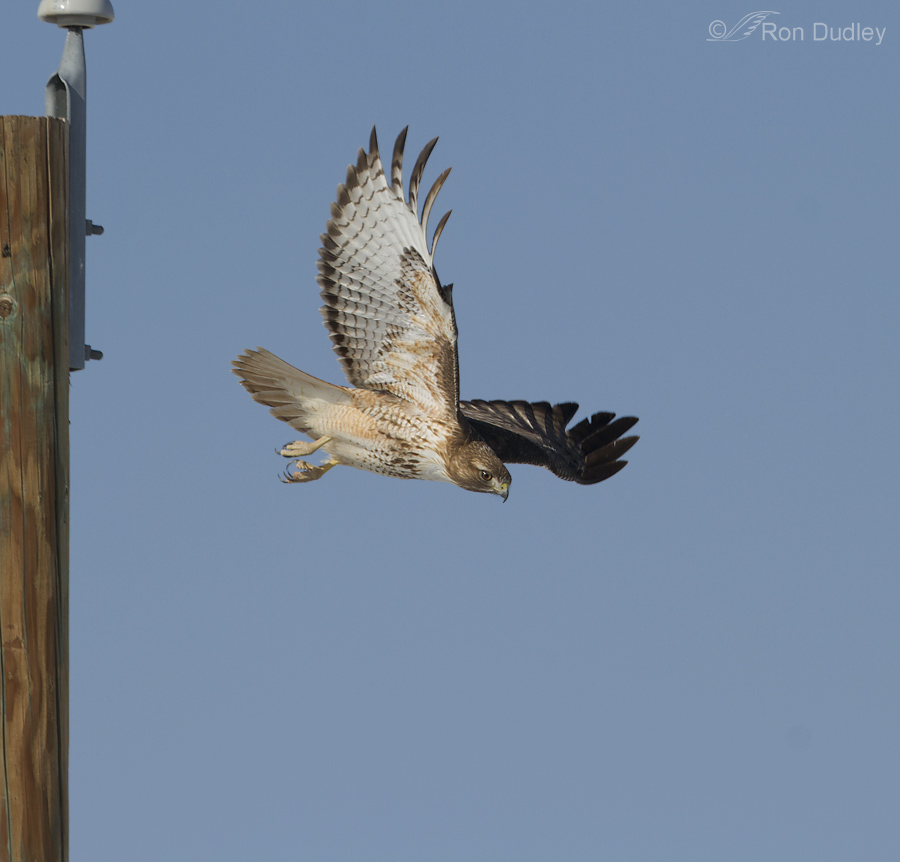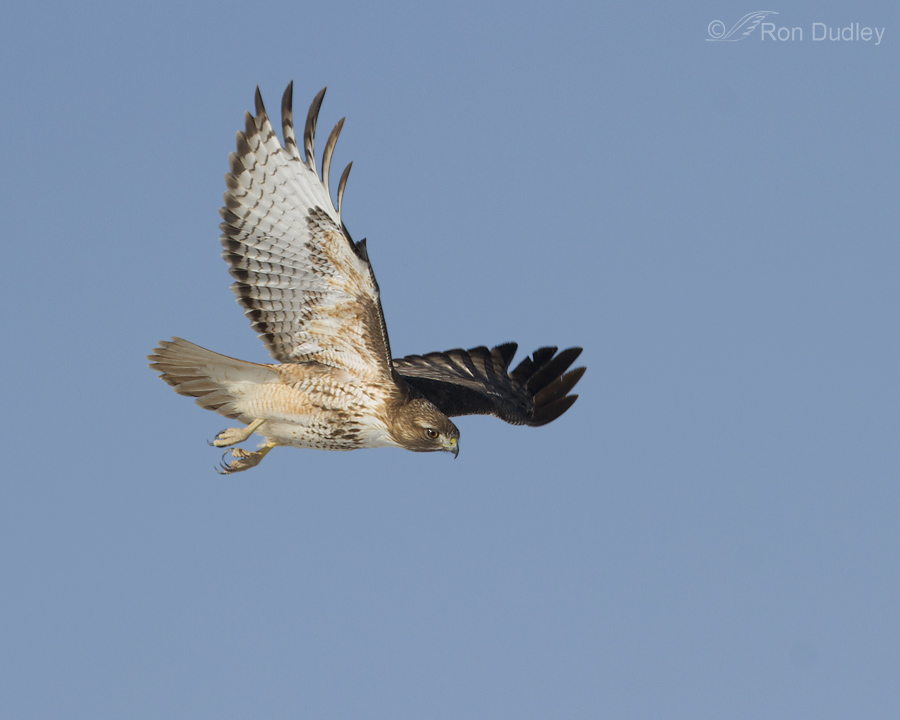This is a simple example of how changing the crop of a photograph can drastically alter one’s perspective on the image.
1/1600, f/8, ISO 500, Canon 7D, 500 f/4, not baited, set up or called in
I photographed this Red-tailed Hawk two weeks ago in Cedar Valley, Utah. With only two elements in the image, the bird and blue sky, there are few visual cues to tell the viewer what’s really going on. The hawk is in flight and the hanging feet suggest recent take-off but beyond that we’re relatively clueless. Among other things we don’t know anything about the recent perch hinted at by the leg angle or even the true angle of flight since there are no indicators of true level in the image. The image could be accidentally or deliberately off-level and need drastic rotation
A different crop tells us much more about reality (though as in this case too much “truth” may not always be a good thing…)

1/1600, f/8, ISO 500, Canon 7D, 500 f/4, not baited, set up or called in
A different crop includes part of the ugly pole from which the hawk took off. This version has been rotated to true level based on the assumption that the pole was close to vertical. The hawk had been perched on top of the insulator at upper left so now we can see how steeply the hawk is dropping from its perch (compare the angle to the first version) – possibly after prey very close to the pole but if so this bird abandoned the attempt and flew to the next pole. The hawk was actually perched on top of a second, dark brown insulator above the white one we can see so it is dropping slightly more steeply than it appears.
As I photographer I also learn something about technique from these types of shots. Take-off shots are difficult because it’s so easy to clip body parts as the wings extend either up or down so being able to predict (to some degree) the vertical angle of take-off can be very helpful. Very large raptors like eagles tend to drop down at takeoff from elevated perches, as do Prairie Falcons. But in my experience Red-tailed Hawks may launch down, horizontally or even slightly upwards. This unpredictable tendency can be frustrating but it’s still valuable to know – for example, when shooting red-tails at take-off I often give them more room in the frame by removing my teleconverter or not approaching too closely.
Much ado about nothing? Perhaps. But us bird photographers need all the help we can get…
Ron



Super shot! I guess it’s simply a matter of preference.
Charlotte
I can’t help myself, I have to ask this question….In your thinking, what is the difference between cropping out a telephone pole and, say, cloning out a telephone wire? I love your work, by the way, and respect your ethics, although as you might be able to tell, I’m not as restrictive as you when it comes to cleaning up an image.
Buff, To my way of thinking, cropping something out of an image is very different from cloning something out. Removing (cloning) an object (either in or out) is changing what was there in the part of the frame that we see and seems less than honest (especially in nature photography) when it isn’t disclosed. I don’t like to do it even when I disclose. When I crop something out of an image I’m not changing anything in the part of the frame that we see. That’s the way I look at it…
Sigh … a healthy supply of feathered subject matter is helpful too, and would please me no end!! I wish I could come out to visit your birdies!! … well … and you guys, too lol!!
Don’t be too jealous, Lois. We have very few birds lately and no light to speak of. Dreary and frustrating.
OOOOOOH! What sharp fingernails you have, Grandma! Sometimes the ugly truth is just that…..ugly! So glad you have the means to eliminate the ugly and preserve the beauty…and the wisdom to do so! Messing around with the bird, altering it, would be something else, but you don’t do that. You give us what you focus on, removing what you eyes edit, like that ugly pole. You see it, but your mind doesn’t hold it’s image like the camera does. Thank you for that.
Thank you, Patty.
Thank you. How very nice to come back to the blogosphere and find beauty and education (as always) with you.
Thank you, Elephant’s Child. Welcome back, I’ve (we’ve) missed you!
Ron, I’ve been enjoying your work for about a month now. The variety of birds (and other wildlife) you have access to and the info you include in your blogs is wonderful! You’re not only a talented photographer, but your knowledge of each subject is admirable. Top notch all the way! You’re comment about removing the teleconverter prompted me to say that you would have an absolute ball with the new Canon EF 200-400mm f/4L IS USM with Internal 1.4x Extender. I’ve been using it for about 6 months and it sure opens up opportunities. I wouldn’t trade it for anything! Keep up the good work!
Thanks very much, Everet. I was intrigued by the new 200-400 with built in extender but ended up buying the new 500 M11 instead (I used version 1 previously). Out here in the west where it’s often difficult to get close to birds I need the extra reach more often than not. It sure would be nice to not have to fumble with converter swapping though…
It’s working well for you. No question about that!
This is indeed most helpful. Thanks, Ron. Beautiful images of a beautiful bird. Love the level of concentration depicted in the images.
Thank you, Sharon.
Thanks for sharing these tips regarding take-off shots.
You’re welcome, Ned. Hope they were helpful.